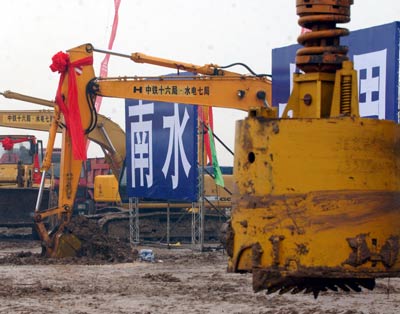|
Water diversion vs heritage protection
(Xinhua)
Updated: 2005-10-09 07:18
While China is stepping up the construction of its south-north water
diversion project, a projected life line for hundreds of millions of people in
the north, a plan for protecting the cultural relics at the construction sites
is still under discussion.

Cranes work at a construction site in
Jiaozuo, Central China's Henan Province September 27, 2005.
[newsphoto] |
The contradiction between modernization and cultural heritage protection is
again in the spotlight in the massive infrastructureproject.
Largest month, an investigation group composed of national advisors, heritage
protection experts and water conservancy experts had an inspection tour along
the route of the water diversion project, including Shandong, Jiangsu, Hubei and
Henan provinces, to see how cultural relics are protected.
"Archeological excavation and heritage protection should have been done
before the start of the project. But the preservation plan has not been approved
yet and the fund is not in place," saidTong Peihua, deputy director of the
archaeological institute of Shandong Province.
In order to tackle the problem of water shortage in the northern part of the
country, China launched the south-north water diversion project at the end of
2002.
The eastern route of the project is expected to supply water to Shandong by
2007. The central route is due to supply water to Henan and Hebei provinces,
Beijing and Tianjin by 2010.
A reservoir of precious Chinese cultural artifacts will be affected by the
project, as it courses through the hinterland of China's ancient civilization.
Many cultural relics are facing the threat of damage as the time and money
spent in heritage protection is far from enough. Some experts have warned that
the project would leave a deep woundin China's cultural heritage without
immediate measures for protection.
The latest figure provided by the State Administration of Cultural Heritage
shows that a total of 788 cultural heritage sites will be affected by the
south-north water diversion project.
They include at least two world heritage sites -- Yuzhen Palaceon the Wudang
Mountain and the Great Wall remains of the Yan State in the Warring States
Period (475-221 BC).
In addition, two heritage sites under national level
protectionand 24 sites under provincial level protection will also be affected.
|